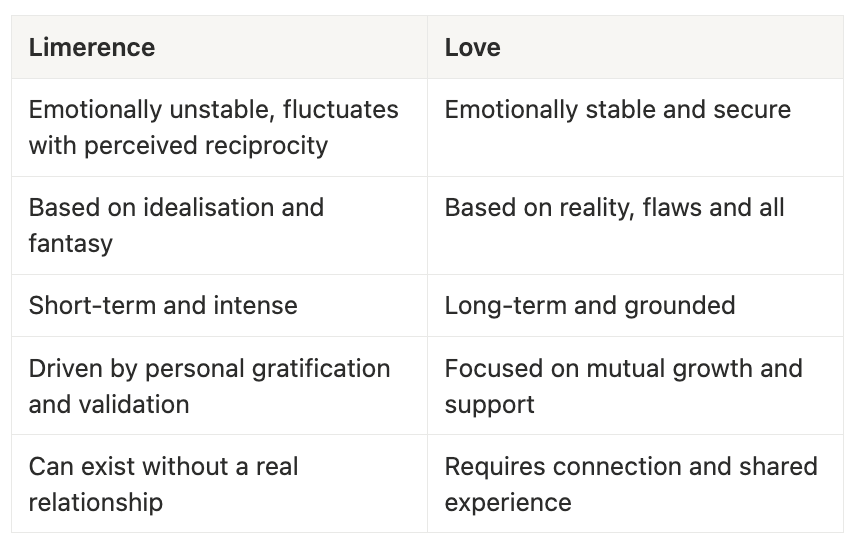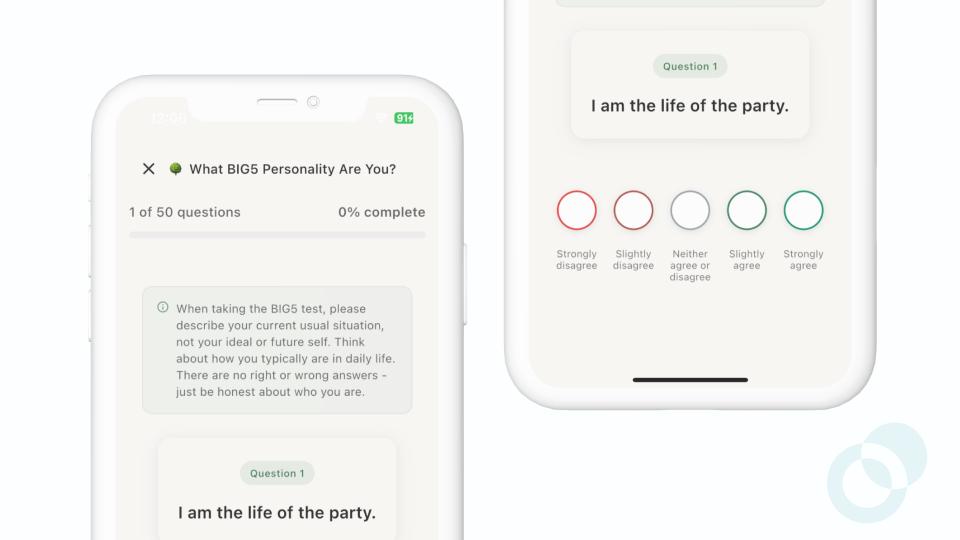
Ghosting and Avoidant Behaviour: Why We Pull Away and 3 Ways to Heal from It
Have you ever experienced ghosting? The two of you were chatting happily the night before, and the next day the person suddenly disappears, never replying again?
Have you ever felt so intensely drawn to someone that you couldn’t stop thinking about them—imagining every possible interaction, decoding every message, overanalysing every glance? If so, you may not be experiencing love, but something more specific: limerence.

Have you ever felt so intensely drawn to someone that you couldn’t stop thinking about them—imagining every possible interaction, decoding every message, overanalysing every glance? If so, you may not be experiencing love, but something more specific: limerence.
In this article, we’ll explore what limerence is, how it differs from genuine love, why it happens from a psychological perspective, and what you can do to manage or move past it.
The term limerence was first introduced by psychologist Dorothy Tennov in 1979 to describe an intense, involuntary emotional state marked by obsessive romantic desire (Tennov, 1979). People in limerence often experience intrusive thoughts about the object of their affection, known as the “limerent object,” along with a strong longing for reciprocation.
Limerence is not just a crush or a passing fancy. It involves a deep psychological obsession with someone, often idealised beyond reality. It may begin like infatuated love, but quickly becomes a fixation that can be emotionally consuming and even distressing.
From a psychological perspective, limerence is driven by both biological and emotional factors. Research shows that intense romantic attraction activates areas in the brain linked to dopamine, the “feel-good” neurotransmitter, which creates a euphoric high similar to that of addiction (Fisher et al., 2002). This is why people experiencing limerence often feel unable to focus, sleep, or even function normally.
Moreover, limerence is frequently connected to one’s attachment style. Those with anxious or avoidant attachment may be more prone to limerent experiences because of deep-rooted fears of rejection or abandonment (Hazan & Shaver, 1987). In these cases, limerence serves as a form of emotional coping, providing fantasy-based fulfilment where security is lacking.
Wondering whether you’re in love or just limerent? Here are some hallmark characteristics of limerence:
You can’t stop thinking about the person, even when it interferes with your daily life.
You see the person as perfect or flawless, often ignoring red flags or incompatibilities.
Your mood swings depending on their behaviour—feeling elated with attention and crushed by disinterest.
Your sense of self-worth begins to depend on how the limerent object responds to you.
You constantly imagine ideal future scenarios with the person, whether or not they’re realistic.
You don’t just want love—you need confirmation that the feelings are mutual, often desperately.
These patterns reflect more than just strong attraction—they are signs of an emotional obsession that can spiral into unhealthy territory.
Although limerence and love may look similar on the surface, they are fundamentally different in nature.

True love involves acceptance, patience, and shared emotional intimacy, while limerence is often about fulfilling a personal emotional need. Limerence thrives on uncertainty—whereas love thrives on trust.
Though it may initially feel euphoric, limerence can take a toll on mental health over time. Obsessive thoughts, anxiety, disrupted sleep, and reduced focus at work or school are common.
Limerence can also prevent people from forming real, healthy relationships. When you’re emotionally tied to an idealised version of someone in dating, especially someone unavailable, it can keep you stuck in a cycle of longing, emotional unavailability and situationship.
If you recognise yourself in these patterns, the good news is: limerence is not permanent. There are constructive ways to understand and shift out of limerent thinking.
Start by recognising that you are in a limerent state. Labelling your feelings can reduce their intensity and give you space to observe them without judgment.
If the person is emotionally unavailable or the relationship is one-sided, it’s helpful to create distance physically and digitally. This interrupts the feedback loop that fuels obsession.
Channel the energy you’re pouring into that person back into yourself—your goals, hobbies, friendships, and emotional growth.
Consider reflecting on your early relationships or working with a therapist to understand how your attachment style may be contributing to limerence.
When you catch yourself idealising or fantasising, try grounding yourself by listing the facts of the person or the relationship. Often, limerence survives on the illusion of possibility.
Techniques like mindfulness practice, meditation, and cognitive behavioural tools can help you regulate obsessive thoughts and improve emotional regulation (Baer, 2003).
While limerence isn’t classified as a mental illness, it can become debilitating. If your wellbeing is significantly affected, consider seeking professional help. Therapists trained in cognitive behavioural therapy (CBT), schema therapy, or attachment-based approaches can support you in breaking these emotional patterns.
Limerence is often misunderstood, dismissed as simple infatuation or romantic drama. But beneath the surface, it offers a valuable mirror into our deepest emotional needs—connection, validation, security. By recognising the signs of limerence and understanding its psychological roots, you can transform obsession into growth, and longing into healing.
After all, love shouldn’t feel like a guessing game or emotional rollercoaster—it should feel like coming home to yourself, with or without someone else.
Caught in the whirlwind of infatuated love or emotional obsession? You don’t have to navigate it alone.
MindForest is your gentle space to pause, reflect, and reconnect with your inner clarity.

💬 Get supportive, AI-powered coaching to move from confusion to calm insight

🧠 Use our guided self-reflection tools to explore what your heart is really telling you

🪞 Track your emotional patterns and learn to recognise attachment cycles

👉 Start your journey with MindForest today — and begin turning obsession into self-awareness.
References
Baer, R. A. (2003). Mindfulness training as a clinical intervention: A conceptual and empirical review. Clinical Psychology: Science and Practice, 10(2), 125–143. https://doi.org/10.1093/clipsy/bpg015
Fisher, H. E., Aron, A., & Brown, L. L. (2002). Defining the brain systems of lust, romantic attraction, and attachment. Archives of Sexual Behavior, 31(5), 413–419. https://doi.org/10.1023/A:1019888024255
Hazan, C., & Shaver, P. (1987). Romantic love conceptualised as an attachment process. Journal of Personality and Social Psychology, 52(3), 511–524. https://doi.org/10.1037/0022-3514.52.3.511
Tennov, D. (1979). Love and Limerence: The Experience of Being in Love. Scarborough House.
Discover practical psychology tips you can apply to your everyday life. From building resilience to improving relationships and finding work-life balance, our blog brings expert-backed insights that help you grow.

Have you ever experienced ghosting? The two of you were chatting happily the night before, and the next day the person suddenly disappears, never replying again?

This article breaks down the psychology of nonchalance, signs of a nonchalant dater, the debate nonchalant vs chalant, and what truly matters when forming modern relationships.

We tend to romanticise chemistry and underestimate compatibility. But in truth, both play essential and very different roles in love. Understanding the psychology behind each can help us make wiser choices in relationships and build connections that are not just passionate but lasting.
Download MindForest and turn these insights into action. Get personalized support from ForestMind AI Coach, track your progress, and unlock your full potential.